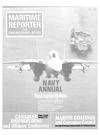
Study Finds No Causal Link Between Crew Size And Maritime Safety
A two-year study of the effect of crew sizes on maritime safety, recently completed by the Marine Board of the National Research Council, was unable to identify a causal link between manning levels and safety. The study was commissioned by the U.S. Coast Guard in light of the worldwide trend toward reduced crews and concerns about the impact on vessel and personnel safety.
Compared to a level of about 45 seafarers 30 years ago, the crew of a typical, newly built U.S.-flag vessel today averages 20 to 24. Some highly automated foreign ships operate with as few an eight to 12 crew members on board.
A "measurable and substantial reduction in vessel casualties and personnel injuries" have been witnessed over the past 20 years while crew size was declining.
The following recommendations were offered at the conclusion of the study by the Marine Board: Congress should modernize manning laws to allow innovation without degrading safety; The U.S. maritime industry, with the aid of the Department of Transportation, should implement a program to demonstrate the conditions under which reduced crew size can be considered safe; The industry, with the aid of DOT, should undertake a research program to determine how human factors such as fatigue and stress affect maritime safety; DOT should gather, standardize, evaluate and disseminate maritime safety data; and The Coast Guard should use formal analytical methods to make manning decisions. The goal should be to develop an internationally accepted method for establishing minimum safe manning levels.
Read Study Finds No Causal Link Between Crew Size And Maritime Safety in Pdf, Flash or Html5 edition of February 1991 Maritime Reporter
Other stories from February 1991 issue
Content
- Deutz-Powered Cruise Sailing Ship Launched At SFCN Shipyard page: 6
- Vancouver Shipyards Wins $35-Million Contract To Overhaul Ferry page: 6
- AK-WA Converts Incinerator Ship, Wins Contract To Modernize LCMs And Rebuilds Fishing Vessel page: 8
- Application For Use Of Foreign-Flag Vessels By U.S. Operator Receives Close Attention By Both MarAd And Congress page: 10
- Sperry Marine Donates Historic Gyrocompass To Museum page: 11
- Saab's Computerized Cargo Handling System Selected By United Tankers Of Sweden page: 11
- Cummins Marine Diesels Power Fire/Rescue Boat For City Of Avalon page: 12
- NABRICO To Build Four Chemical Barges For Maryland Marine page: 12
- Moran Towing Appoints Three New Vice Presidents page: 14
- Stewart & Stevenson Receives $20-Million Order For Gensets page: 14
- Hampton Roads Complex Poised For Substantial Expansion In 1991 page: 15
- Singmarine Acquires Two Docks To Cope With Increased Work Volume page: 15
- Versatile Pacific Delivers Search And Rescue Vessel To Canadian Coast Guard page: 16
- SNAME And SSC To Sponsor MSIMMS '91 Symposium In Arlington, March 18-19 page: 16
- Bird-Johnson Appoints Peter J. Gwyn New President & COO page: 18
- SpillStop® Technique Prevents Oil Spillqge After Tanker Accidents page: 19
- Los Angeles Shipyard Corporation Looks To Lease Todd Facility page: 20
- Tests Begin On Engine Developed By MAN B&W, SEMT Pielstick page: 20
- Southern Marine Industries page: 22
- Detyens Shipyards Refits 465-Foot Bulk Carrier page: 27
- Sperry Marine Chosen For Japan Corporate Program page: 27
- Sumitomo To Launch $59 Million Double-Skin, Double-Bottomed Tanker page: 28
- Conoco To Increase Spending To $2 Billion In 1991 page: 28
- Aquamaster Brochure Describes Products And Services Offered page: 28
- MARCO-Seattle Yard Busy With Fishing Vessel Construction, Conversion page: 30
- Schuyler Rubber, Marine Fender Firm, Receives Recycling Award page: 30
- COATINGS & CORROSION CONTROL page: 32
- Study Finds No Causal Link Between Crew Size And Maritime Safety page: 37
- Avondale Boat Division To Build 3,900-HP Tug For U.S. Owner page: 38
- Gulf Crisis Confirms Need For Global Naval Force page: 40
- H. LAWRENCE GARRETT I Secretary Of The Navy page: 41
- Navy Announces Ship Repair Schedule For FYs 91-92 page: 44
- VADM. John W. Nyquist Calls For Stable Shipbuilding Budget page: 44
- NAVY SEALIFT SHIP PROGRAM TO INJECT $1.3 BILLION INTO U.S. MARITIME INDUSTRY DEFENSE DEPARTMENT PLANNING 5 YEAR PROGRAM page: 46
- MAJOR NAVY CONTRACTS page: 47
- Lasers For Ship Defense Examined By U.S. Navy page: 52
- Nuclear Sub Launched Using NEI Syncrolift For First Time Ever page: 53
- U.S. Government Awards Ship Repair Contracts page: 53
- USS Chosin Joins Pacific Fleet — 13th Aegis Cruiser By Ingalls page: 54
- A / S Deif Offers Automatic Control For Auxiliary Engines page: 55
- Benmar Offers New Fuel Management System To Commercial Industry page: 55
- PSRY Contractors Complete Busy Year —Literature Offered page: 57
- New Decrees Will Free Brazilian Ship Operators From Previous Regulations page: 59
- Shipbuilders Council Announces 1991 Legislative Agenda page: 60
- Esso international Installs AMOS-D On Board Tanker Fleet page: 60
- Sulzer Diesel Changes Name Following Majority Stock Transfer page: 61
- CANADIAN MARITIME INDUSTRIES ASSOCIATION'S 43RD ANNUAL TECHNICAL CONFERENCE page: 64
- AT&T Radiotelephone Service Helps Keep In Touch On The High Seas page: 65
- AESA To Build Car/Passenger Ferry For Moroccan Owner page: 66
- World Shipyards Capable Of Producing 'Only 40 VLCCs A Year page: 66
- Drewry Study Concludes Era Of Cheaply Acquired And Run Ships Has Ended page: 66
- Global Maritime Fabricates First Swirling Flow Research Combustor page: 66
- Ship Safety Achievement, Jones F. Devlin Awards Announced By AIMS page: 67
- Impact Of Lifting Alaskan North Slope Oil Export Ban On The U.S. Maritime Industry page: 68
- Bender To Construct Two Jackup Vessels For Work In Gulf Of Mexico page: 69
- Air-Independent Mini-Sub Designed By Thyssen page: 69
- New Diesel Engine Maintenance Tool Brochure Offered By Chris-Marine page: 69
- Avondale Begins Construction Of Cargo Variant Ship page: 70
- Ships Built With Foreign Subsidies Might Face Sanctions page: 70
- Shipbuilders Council Of America Seminar On Ship Marketing, Finance To Be Held February 12-13 page: 70
- Skaarup Announces Personnel Changes page: 71
- Lips Offers New Brochure On Marine Propellers And Steerable Thrusters page: 71
- Offshore Symposium Set For Houston, April 4-5 page: 71
- Trinity Marine To Build Fourth Supply Boat For U.S. Owner page: 72
- Oceaneering Awarded Mobile Offshore Production Systems Contract page: 72
- Marine Industries Northwest Repowers Washington State Ferry page: 72
- Bethlehem Steel Sells Two Ore Carriers To Oglebay Norton page: 73
- Tidewater To Supply 41 Tugs, Barges Under Two Multiyear Contracts page: 73
- Rauma Yards Launches Luxury Cruise Ship page: 73


